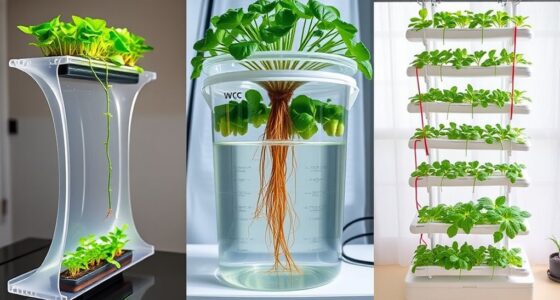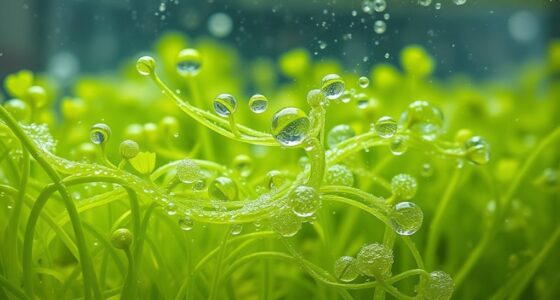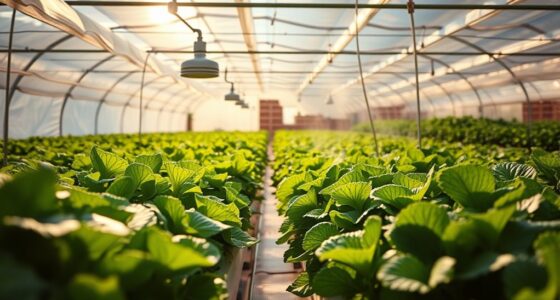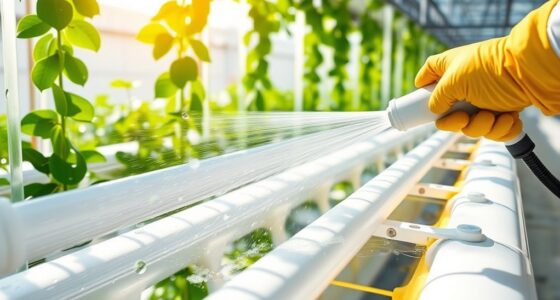To prevent root rot in hydroponics, you can choose between sterile and organic approaches. Sterile methods focus on disinfecting equipment, using high-quality water, and maintaining strict hygiene to eliminate pathogens. Organic strategies promote beneficial microbes and natural amendments that support resilient root systems. Combining these methods or selecting the right approach based on your setup helps control diseases effectively. Keep exploring to discover the best techniques suited for your hydroponic system and guarantee healthy roots.
Key Takeaways
- Sterile methods focus on equipment sanitation, pathogen suppression, and chemical control; organic methods promote beneficial microbes and natural soil health.
- Maintaining proper pH and nutrient balance is essential in both approaches to prevent conditions conducive to root rot.
- Sterile hydroponics minimizes microbial growth through sterilization, while organic methods enhance microbial diversity to outcompete pathogens.
- Regular monitoring and timely adjustments are critical, regardless of approach, to prevent nutrient lockout and pH fluctuations.
- Combining sterile techniques with organic practices can create a resilient system that minimizes root rot risk effectively.
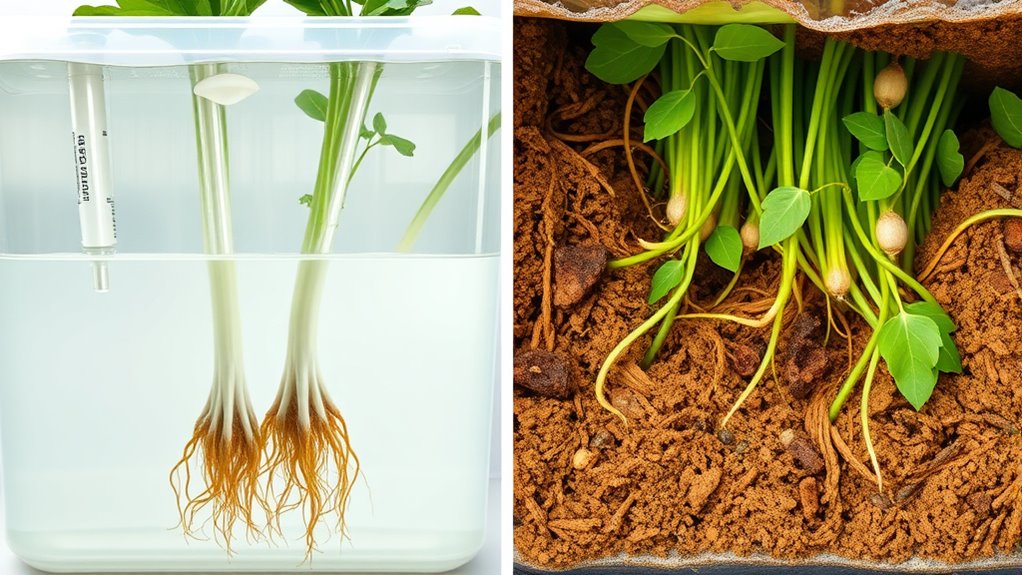
Root rot is a common but preventable problem that can quickly kill your plants if left unchecked. One of the main causes of root rot is poor water and nutrient management, which often stems from nutrient imbalances and improper pH regulation. When your nutrient solution’s pH drifts outside the ideal range, it can lock out essential minerals, leading to deficiencies or toxicities that weaken roots and make them vulnerable to rot. Maintaining consistent pH levels, typically between 5.5 and 6.5 in hydroponics, ensures your plants absorb nutrients properly and stay healthy. Regular testing and adjustments are critical; neglecting this can cause nutrient imbalances that favor pathogenic growth and root decay.
Maintaining proper pH is crucial to prevent nutrient lockout and root rot in hydroponic systems.
In hydroponic systems, preventing root rot begins with understanding the importance of nutrient balance. You need to supply your plants with the right amount of macro- and micronutrients, avoiding excesses that can create an environment conducive to microbial overgrowth. Overfeeding can lead to salt buildup, which can stress roots and hinder their oxygen intake, increasing the risk of rot. Conversely, deficiencies weaken plant health, making roots less resilient. Carefully monitoring your nutrient solution’s composition and replacing it regularly helps keep nutrient levels stable, preventing imbalances that could compromise root health. Additionally, using an airless sprayer for applying foliar nutrients can help minimize water contact with roots and reduce disease risk.
Sterile approaches focus on maintaining a clean environment to prevent root rot. You start by sterilizing all equipment, including reservoirs, pumps, and growing containers, before use. This minimizes the introduction of harmful fungi and bacteria that can cause rot. Using sterile, high-quality nutrient solutions and avoiding contaminated water sources also reduce infection risks. Additionally, some growers incorporate beneficial microbes or biofungicides to outcompete or suppress pathogens naturally. These methods are effective but require meticulous maintenance and a strict hygiene routine to ensure no contaminants enter the system.
Organic approaches emphasize creating a balanced, healthy ecosystem for your plants. You can do this by using organic nutrients and amendments that support beneficial microbial activity, which naturally suppresses harmful pathogens. Proper aeration and oxygenation of the root zone are essential, as roots need oxygen to resist rot. Organic growers often focus on maintaining soil or substrate health through compost teas, beneficial microbes, and natural soil conditioners. These methods foster a resilient root environment that can fend off diseases without relying heavily on sterilization or chemical controls.
Both sterile and organic methods aim to keep roots healthy and rot-free, but they differ in approach. Sterile techniques prioritize cleanliness and the prevention of contamination through rigorous sanitation, while organic strategies focus on building a robust, microbial-friendly environment. Whichever approach you choose, controlling nutrient imbalances and pH regulation remains fundamental to avoiding root rot and ensuring your hydroponic plants thrive.
Frequently Asked Questions
Can Beneficial Microbes Fully Prevent Root Rot in Hydroponic Systems?
Beneficial microbes can considerably reduce the risk of root rot in your hydroponic system, but they might not fully prevent it. By promoting microbial diversity and using organic amendments, you create a healthier root environment that suppresses harmful pathogens. However, maintaining ideal water quality, proper aeration, and hygiene practices are essential. Combining microbial strategies with good system management offers the best chance to prevent root rot effectively.
How Often Should Sterilization Procedures Be Performed for Optimal Prevention?
You should establish a regular disinfection frequency and sterilization schedule to keep your hydroponic system healthy. Typically, sterilization should be performed every one to two weeks, depending on your system’s size and the level of contamination risk. Consistent cleaning prevents pathogen buildup and reduces root rot chances. Adjust your sterilization schedule based on system observations, ensuring you maintain a clean environment that promotes healthy plant growth and minimizes disease.
Are Organic Methods Equally Effective in Preventing Root Rot as Sterile Techniques?
You wonder if organic methods can match sterile techniques in preventing root rot. While natural remedies like beneficial microbes and organic treatments work to boost plant health, they may not always prevent root rot as effectively as chemical treatments or sterile procedures. Both approaches aim to stop pathogens, but sterile techniques often offer more immediate control, whereas organic methods build resilience over time. Your choice depends on your preference for natural solutions or rapid results.
What Are the Signs That Root Rot Is Developing Despite Prevention Efforts?
You should watch for early warning signs that root rot might be developing despite your prevention efforts. Look for discolored, slimy roots or a foul smell, which indicate infection. Regular system monitoring helps catch issues early, allowing you to act before roots deteriorate. If you notice sluggish plant growth or leaf yellowing, these could also signal root health problems, prompting immediate inspection and intervention to save your plants.
Does Water Temperature Influence the Effectiveness of Root Rot Prevention Methods?
Water temperature notably influences the effectiveness of root rot prevention methods because it affects microbial activity. When water is too warm, microbial activity speeds up, which can either help fight pathogens or promote their growth, depending on the microbes present. Cooler water generally slows microbial activity, reducing disease spread. You should maintain ideal water temperature to support beneficial microbes, ensuring they outcompete or inhibit root rot pathogens, making your prevention efforts more effective.
Conclusion
Think of your hydroponic system as a delicate garden of glass—vulnerable but resilient. By choosing either sterile or organic methods, you’re building a strong shield against root rot, much like a gardener tending to their prized plants. Stay vigilant, keep conditions balanced, and act quickly at the first sign of trouble. With these approaches, you’ll nurture a thriving, healthy root system that’s the backbone of your lush, flourishing garden.



